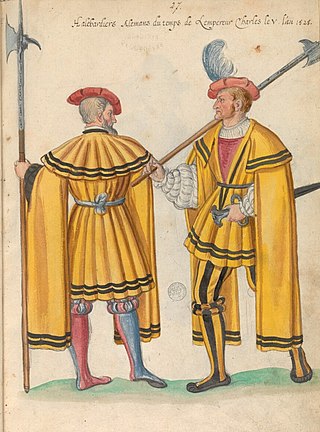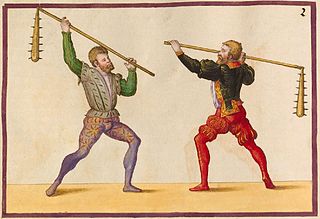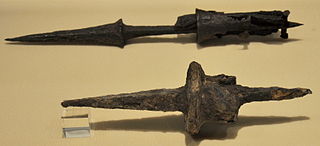
A polearm or pole weapon is a close combat weapon in which the main fighting part of the weapon is fitted to the end of a long shaft, typically of wood, extending the user's effective range and striking power. Polearms are predominantly melee weapons, with a subclass of spear-like designs fit for thrusting and/or throwing. Because many polearms were adapted from agricultural implements or other fairly abundant tools, and contained relatively little metal, they were cheap to make and readily available. When belligerents in warfare had a poorer class who could not pay for dedicated military weapons, they would often appropriate tools as cheap weapons. The cost of training was comparatively low, since these conscripted farmers had spent most of their lives using these "weapons" in the fields. This made polearms the favoured weapon of peasant levies and peasant rebellions the world over.
A spear is a pole weapon consisting of a shaft, usually of wood, with a pointed head. The head may be simply the sharpened end of the shaft itself, as is the case with fire hardened spears, or it may be made of a more durable material fastened to the shaft, such as bone, flint, obsidian, copper, bronze, iron, or steel. The most common design for hunting and/or warfare, since ancient times has incorporated a metal spearhead shaped like a triangle, diamond, or leaf. The heads of fishing spears usually feature multiple sharp points, with or without barbs.
A war hammer is a weapon that was used by both foot soldiers and cavalry. It is a very old weapon and gave its name, owing to its constant use, to Judah Maccabee, a 2nd-century BC Jewish rebel, and to Charles Martel, one of the rulers of France. In the 15th and 16th centuries, the war hammer became an elaborately decorated and handsome weapon.

A halberd is a two-handed polearm that came to prominent use from the 13th to 16th centuries. The halberd consists of an axe blade topped with a spike mounted on a long shaft. It can have a hook or thorn on the back side of the axe blade for grappling mounted combatants. The halberd was usually 1.5 to 1.8 metres long.

A quarterstaff, also short staff or simply staff is a traditional European pole weapon, which was especially prominent in England during the Early Modern period.

A longsword is a type of European sword characterized as having a cruciform hilt with a grip for primarily two-handed use, a straight double-edged blade of around 80 to 110 cm, and weighing approximately 1 to 1.5 kg.

A pike is a long thrusting spear formerly used in European warfare from the Late Middle Ages and most of the early modern period, and wielded by foot soldiers deployed in pike square formation, until it was largely replaced by bayonet-equipped muskets. The pike was particularly well known as the primary weapon of Swiss mercenary, German Landsknecht units and French sans-culottes. A similar weapon, the sarissa, had been used in antiquity by Alexander the Great's Macedonian phalanx infantry.

A morning star is any of several medieval club-like weapons consisting of a shaft with an attached ball adorned with one or more spikes. Each used, to varying degrees, a combination of blunt-force and puncture attack to kill or wound the enemy.

A flail is a weapon consisting of a striking head attached to a handle by a flexible rope, strap, or chain. The chief tactical virtue of the flail was its capacity to strike around a defender's shield or parry. Its chief liability was a lack of precision and the difficulty of using it in close combat, or closely-ranked formations.

A rondel dagger or roundel dagger is a type of stiff-bladed dagger used in Europe in the late Middle Ages, used by a variety of people from merchants to knights. It was worn at the waist and could be used as a utility tool, or worn into battle or in a jousting tournament as a side arm.

A club is a short staff or stick, usually made of wood, wielded as a weapon since prehistory. There are several examples of blunt-force trauma caused by clubs in the past, including at the site of Nataruk in Turkana, Kenya, described as the scene of a prehistoric conflict between bands of hunter-gatherers 10,000 years ago.

A bardiche, berdiche, bardische, bardeche, or berdish is a type of polearm used from the 14th to 17th centuries in Europe. Ultimately a descendant of the medieval sparth axe or Dane axe, the bardiche proper appears around 1400, but there are numerous medieval manuscripts that depict very similar weapons beginning c. 1250. The bardiche differs from the halberd in having neither a hook at the back nor a spear point at the top. The use of bardiches started in early 14th-century Austria.

A voulge is a type of polearm that existed in medieval Europe, primarily in 15th century France.

The Lochaber axe is a type of poleaxe that was used almost exclusively in Scotland. It was usually mounted on a staff about five feet long.
Darts are airborne ranged weapons. They are designed to fly such that a sharp, often weighted point will strike first. They can be distinguished from javelins by the presence of fletching and a shaft that is shorter and/or more flexible. Darts can be propelled by hand or with the aid of a hand-held implement such as a blowgun. They can be distinguished from arrows because they are not used with a bow.

The cinquedea, or cinqueda is a civilian short sword. It was developed in northern Italy and enjoyed a period of popularity during the Italian renaissance of the 15th and early 16th centuries.

The doloire or wagoner's axe was a tool and weapon used during the Middle Ages and Renaissance. The axe had a wooden shaft measuring approximately 1.5 metres (5 feet) in length and a head that was pointed at the top and rounded at the bottom, resembling either a teardrop or an isosceles triangle. The top of the shaft was fitted with a metal eye or socket that was welded to the head of the axe near the base of the blade. The upper part of the blade extended above the eye, while the opposite side of the socket featured a small blunt hammer head. The head of the axe itself measured approximately 44 cm. (17 inches) in length, was sharpened on the back and flattened bottom edges, and was uniformly decorated with punched and incised abstract floral patterns.

A goedendag was a weapon originally used by the militias of Medieval Flanders in the 14th century, notably during the Franco-Flemish War. The goedendag was essentially a combination of a club with a spear. Its body was a wooden staff roughly 90 cm to 150 cm long with a diameter of roughly 5 cm to 10 cm. It was wider at one end, and at this end a sharp metal spike was inserted by a tang.

The Swiss developed a number of characteristic weapons during their period of military activity in the 15th and early 16th centuries, perfected further during the Early Modern period.

Mughal weapons significantly evolved during the ruling periods of its various rulers. During its conquests throughout the centuries, the military of the Mughal Empire used a variety of weapons including swords, bows and arrows, horses, camels, elephants, some of the world's largest cannons, muskets and flintlock blunderbusses.

















